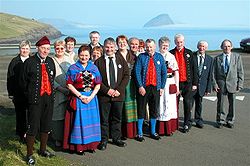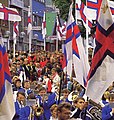Faroe Islanders
 Faroese folk dancers from the island of Vágar in national costumes | |
| Total population | |
|---|---|
| c. 70,000–73,600[a] | |
| Regions with significant populations | |
| c. 50,000[1] | |
| 21,687[2] | |
| 1,981[3][dubious – discuss] | |
| Languages | |
| Faroese, Danish (Gøtudanskt accent) Historically: Old Norse and Norwegian as well | |
| Religion | |
| Lutheranism (Church of the Faroe Islands) Historically also the Norse paganism and Roman Catholicism (1000–1538) | |
| Related ethnic groups | |
| Danes, Norwegians, Swedes, Icelanders, Irish, Scots, and modern Celtic peoples in general | |
| Part of a series on the |
| Culture of the Faroe Islands |
|---|
 |
| History |
| Menschen |
| Languages |
| Mythology and folklore |
| Cuisine |
| Festivals |
| Religion |
| Kunst |
| Literature |
| Music |
| Sport |
Faroese people or Faroe Islanders (Faroese: føroyingar; Danish: færinger) are an ethnic group native to the island country of the Faroe Islands situated in the North Atlantic Ocean, where they form the vast majority of the population.[4] The Faroese are of mixed Norse and Gaelic origins, as are the Icelanders with whom they are closely related.[5]
About 21,000 Faroese live in neighbouring countries, particularly in Denmark, Iceland, and Norway. Most Faroese are citizens of the Kingdom of Denmark, in which the Faroe Islands are a constituent nation. The Faroese language is one of the North Germanic languages and is closely related to Icelandic and Norwegian (including, most notably, a series of southwestern Norwegian dialects).[6]
In addition, the Faroese language is one of the two North Germanic languages which are the closest related to Old Norse from which both were descended, alongside Icelandic. Furthermore, Faroese was also related to the extinct language Norn which was spoken in the past in the Orkneys and Shetland archipelagos, situated off the northeastern coast of Scotland. At the same time, as in the case of Icelandic, there are words of Gaelic origin in the Faroese language (e.g. place names, proper names, etc.).[7]
Origins and history
The first known settlers of the Faroe Islands were Gaelic hermits and monks who arrived in the 6th century, during the Early Middle Ages, more specifically the Papar, according to the Icelandic sagas, as it was the case of Iceland as well.[8] Of these hermit monks, it is possible that Brendan the Navigator spotted and visited them on through one of his voyages.[9] Moreover, according to DNA tests, sheep were introduced to the Faroe Islands c. 300 years prior to the arrival of the Norsemen.[10]

From the 9th century onwards, the Norse–Gaels came to the archipelago, settled it, and brought both the Norse and Gaelic cultures as well as the Old Norse and Gaelic languages to the islands. Little is known about this period, thus giving room for speculation. A single source mentions early settlement, the Icelandic Færeyinga saga (i.e. the Saga of the Faroe Islands). It was written sometime around 1200 and explains events taking place approximately 300 years prior. According to the saga, many Norsemen objected to the Norwegian king's unification politics (in the time of King Harald Fairhair, more specifically) and thus fled to other countries, including the newfound places in the west across the North Atlantic Ocean.[11]
Historians have discovered the fact that, since the time of the Færeyinga saga, the Viking Grímur Kamban was the first settler in the Faroes. The Norwegians must have known about the isles before leaving Norway. If Grímur Kamban had settled sometime earlier, this could explain the Norwegians' knowledge of them. Another, more logical explanation might be that the Gaels of Scotland and Ireland told the Norwegians of the islands prior to their arrival and colonisation there.
While Grímur is an Old Norse first name, Kamban indicates a Celtic/Gaelic origin. Thus, he could have been a man from Ireland, Scotland or Isle of Man, where the Norsemen already had settlements. Some place names from the oldest settlements on the Faroes suggest that some of the settlers perhaps came from the Scottish islands and parts of the British coast respectively.
Y chromosomes, tracing male descent, are 87% Scandinavian,[12] but mitochondrial DNA, tracing female descent, is 84% Celtic/Gaelic from Ireland and Scotland.[5]
-
Faroese stamp commemorating Grímur Kamban, the first Norse–Gaelic settler of the Faroe Islands
-
Elderly Faroese couple in the 1940s, wearing their traditional 'Sunday dress' for Church
-
Three Faroese women wearing traditional regalia. The student caps identify them as newly graduated.
-
Faroese people with the Faroese national flag at the Ólavsøka summer festival (the biggest summer festival in the Faroe Islands) on Niels Finsen's street in Tórshavn, the capital of the Faroe Islands
Culture

The culture of the Faroese people is similar to that of the Icelanders and the rest of the Scandinavians. Faroese culture includes Faroese literature, Faroese music, Faroese art, and Faroese cinema. Kvæði are the old ballads of the Faroese people recited along with traditional chain dances. A notable and well known Faroese musician is Eivør Pálsdóttir. The culture of the Faroe Islanders also includes the iconic houses with turf roofs, very similar or almost identical in architectural regards to those in Iceland and Norway. The architecture of the turf houses was imported by the Norse settlers from Norway both in the Faroe Islands and in Iceland during the Viking Age.
See also
- List of Faroese people
- Demographics of the Faroe Islands
- Culture of the Faroe Islands
- Flag of the Faroe Islands
- Faroese Dane
Notes
- ^ The total latter amount according to the aggregate data from the infobox below for all the countries.
References
- ^ According to a 2009 estimate, the population of the Faroe Islands was 49,000, ~92% of that population was Faroese born, which is approximately 45,000. (See demographics of the Faroe Islands)
- ^ Politiken Archived 3 March 2016 at the Wayback Machine, 2006 (newspaper written in Danish)
- ^ "Table 5 Persons with immigrant background by immigration category, country background and sex. 1 January 2009". www.ssb.no. Archived from the original on 20 August 2020. Retrieved 23 July 2019.
- ^ Minahan, James (2000). One Europe, many nations: a historical dictionary of European national groups. Greenwood Publishing Group. p. 769. ISBN 0313309841. Archived from the original on 16 January 2023. Retrieved 25 May 2013.
- ^ a b Als, T. D.; Jorgensen, T. H.; Børglum, A. D.; Petersen, P. A.; Mors, O.; Wang, A. G. (2006). "Highly discrepant proportions of female and male Scandinavian and British Isles ancestry within the isolated population of the Faroe Islands". European Journal of Human Genetics. 14 (4): 497–504. doi:10.1038/sj.ejhg.5201578. PMID 16434998.
- ^ "Faroese language". Encyclopædia Britannica. Retrieved 31 October 2023.
- ^ "The Faroese Language". University of Valencia. Retrieved 31 October 2023.
- ^ "20 things you didn't know about The Faroe Islands – BelfastTelegraph.co.uk". BelfastTelegraph.co.uk. Archived from the original on 1 August 2021. Retrieved 23 August 2017.
- ^ Jonathan Williamson. "The Viking history of the Faroe Islands: An introduction". The Viking Herald. Retrieved 31 October 2023.
- ^ Jamie Priest (17 December 2021). "Faroe Islands were settled 300 years before the Vikings arrived". Cosmos Magazine. Retrieved 31 October 2023.
- ^ Anthony Faulkes (2016). "Færeyinga saga" (PDF). Viking Society Web Publications. Retrieved 29 October 2023.
- ^ Jorgensen, T. H.; Buttenschön, H. N.; Wang, A. G.; Als, T. D.; Børglum, A. D.; Ewald, H. (2004). "The origin of the isolated population of the Faroe Islands investigated using Y chromosomal markers". Human Genetics. 115 (1): 19–28. doi:10.1007/s00439-004-1117-7. PMID 15083358. S2CID 6040039.
Further reading
- Arge, Símun, Guðrun Sveinbjarnardóttir, Kevin Edwards, and Paul Buckland. 2005. "Viking and Medieval Settlement in the Faroes: People, Place and Environment". Human Ecology. 33, no. 5: 597–620.






